This is my go-to steak recipe when I want something special without the steakhouse fuss. It’s juicy, buttery, perfectly seared—and honestly, it turns out better than most steaks I’ve paid way too much for. Add a little garlic, a splash of butter, and that golden crust? Pure magic!
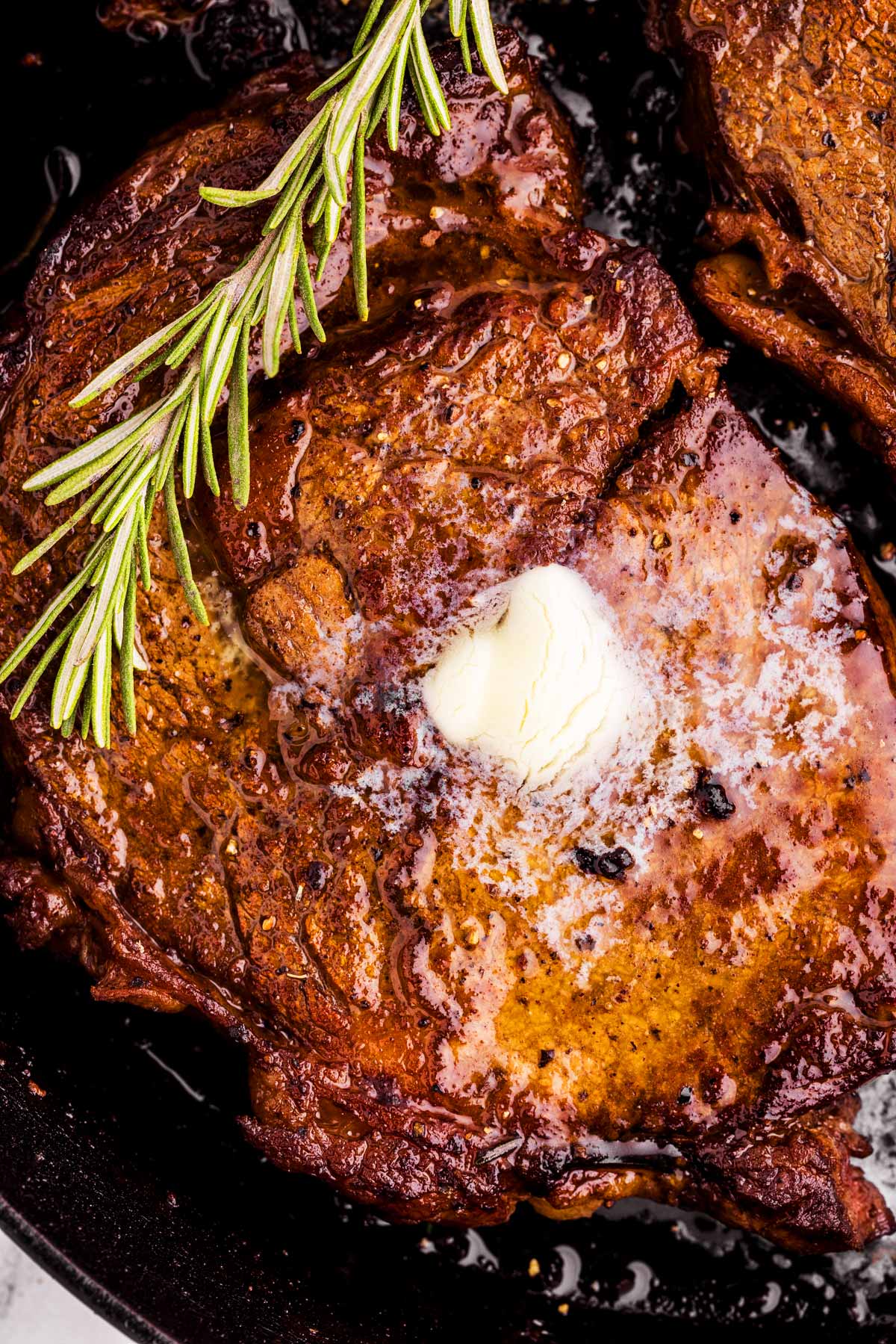
Why this steak is worth skipping the restaurant
I don’t do steak often—but when I do, it needs to be perfect. Deep sear. Juicy center. Sizzle-meets-butter-meets-garlic kind of vibe. And this pan-seared method? It delivers—no steakhouse reservation required.
Here’s what makes it special:
- We’re not skipping the butter baste. This is the moment. A sizzling spoonful of melted butter, garlic, and rosemary turns a regular steak into a swoon-worthy one. It’s not optional. It’s the moment.
- We start with a room temp, dry steak. Not juicy. Not straight from the fridge. Letting the steak sit at room temp and patting it dry gives you that gorgeous crust. You know, the kind that makes you feel like a pro.
- No guesswork on doneness. The temperature guide is built right in—and we pull the steak before it hits your ideal temp. That little rest window? That’s when the magic happens. Juicy steak, every single time.
- You’re in charge. No weird steakhouse lighting, no upsells, and definitely no $18 sides. Just you, your skillet, 20mins and a steak that’ll make you feel like an absolute boss!
Printable recipe
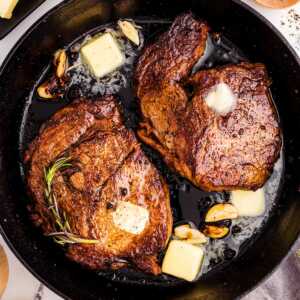
Pan Seared Steak
Ingredients
- 2 New York Strip steaks (Ribeye, or Top Sirloin Steaks (1 ¼” thick; weight according to your needs))
- 1 teaspoon coarse sea salt (adjust to taste; use about ½ teaspoon if using table salt)
- ½ teaspoon freshly ground black pepper (or more to taste)
- ½ Tbsp high-heat oil (vegetable, canola, avocado, or extra-light olive oil)
- 2 tablespoons unsalted butter
- 2 cloves garlic (smashed)
- 1 sprig fresh rosemary (or thyme for a different flavor)
Instructions
- Prepare steak: Pat steaks thoroughly dry with paper towels. Let sit at room temperature for 30-40 minutes before cooking for even searing. Just before cooking, season generously with salt and pepper on all sides.2 New York Strip steaks, 1 teaspoon coarse sea salt, ½ teaspoon freshly ground black pepper
- Preheat pan: Heat a cast iron skillet over medium-high heat until very hot (but not smoking). Add oil and swirl to coat. The oil should shimmer but not smoke excessively.½ Tbsp high-heat oil
- Sear steak: Place steaks in the pan and do not move them for 4 minutes to create a deep brown crust. Flip and sear the second side for 3-4 minutes. Using tongs, turn the steak on its edges and sear the sides, including the fatty edge, for 1 minute per side.
- Baste with butter: Reduce heat to medium and add butter crushed garlic and rosemary. Once the butter melts, tilt the pan and spoon the butter continuously over the steak for 1 minute or until the steak is 5-10°F below your desired doneness (it will continue cooking as it rests).Steak Doneness GuideRare: Remove at 120°F (final temp: 125°F)Medium-Rare: Remove at 125°F (final temp: 130°F)Medium: Remove at 135°F (final temp: 140°F)Medium-Well: Remove at 145°F (final temp: 150°F)Well Done: Remove at 155°F (final temp: 160°F)2 tablespoons unsalted butter, 2 cloves garlic, 1 sprig fresh rosemary
- Rest and serve: Transfer steak to a cutting board and loosely cover with foil. Let rest for 10 minutes before serving. Spoon any remaining butter sauce over the steak. If slicing to serve, always cut against the grain.
Tips for steak success (aka how to not mess this up)
- Let your steak hang out on the counter. Give it ~30 minutes at room temp before it hits the pan. It helps it cook evenly and gives you that perfect pink center instead of a ring of regret around raw steak.
- Dry steak = happy sear. Pat it bone dry with paper towels. Moisture = steam = sad gray steak. Dry = crusty, golden perfection.
- Get that pan HOT. Cast iron is my ride-or-die here (although a good stainless will work). You want it preheated and shimmering before the steak goes in. If it’s not making noise when you drop it in, your pan isn’t ready.
- Don’t poke it. Give it a good 3–4 minutes before flipping. That untouched time is when the crust forms—don’t ruin the magic with fidgety flipping.
- Butter bath = flavor bomb. After searing, you’ll spoon melted butter over the steak with smashed garlic and rosemary. It’s fast. It’s fancy. It makes you feel like you’re hosting a cooking show.
- Let it rest. If you cut into it too soon, all those juices will end up on your cutting board instead of in your mouth. Give it 10 minutes. It’s worth the wait.
Ingredient notes (and why I care so much)
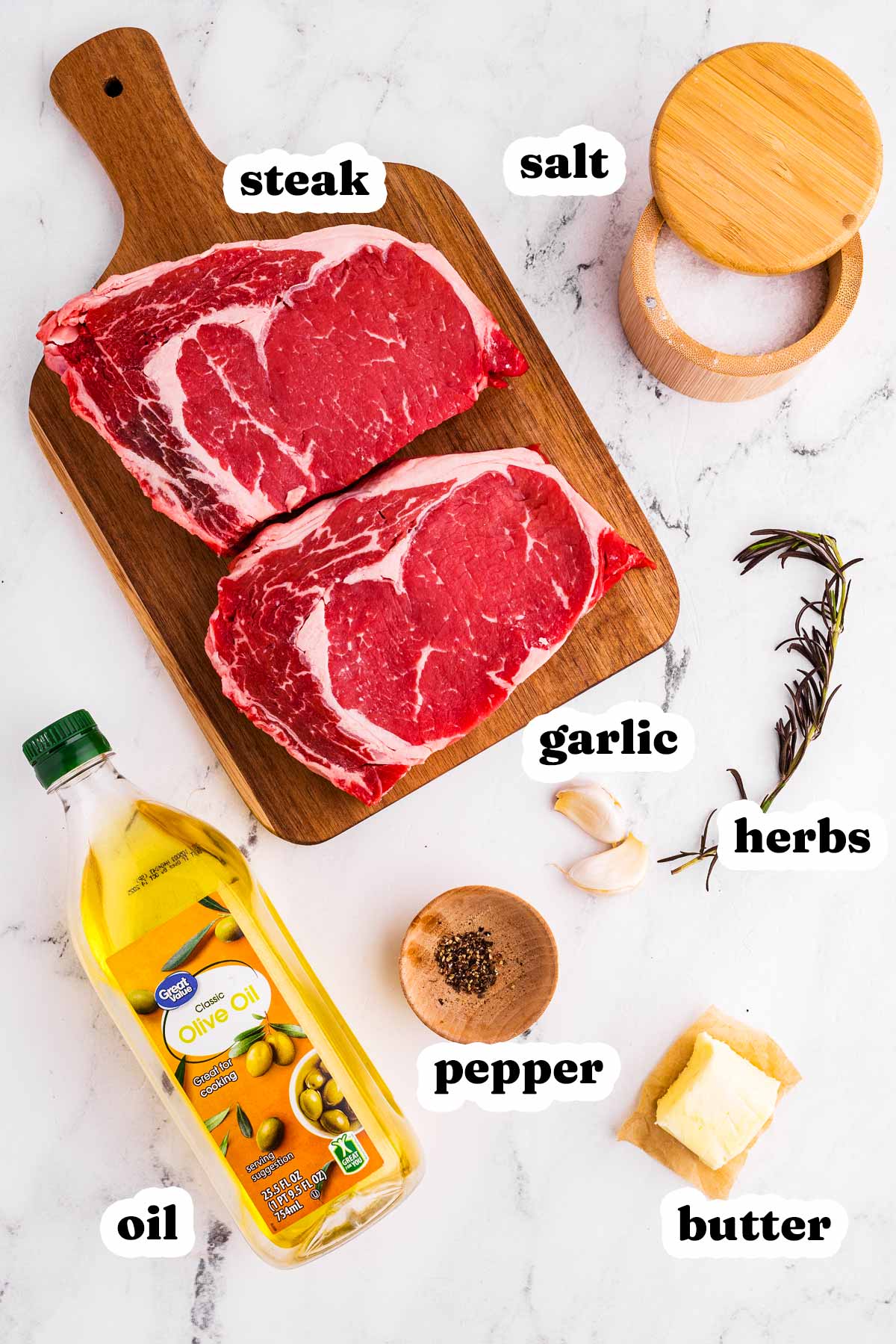
- Steak: New York Strip, Ribeye, or Top Sirloin are all solid picks. Just make sure it’s about 1¼” thick—none of those thin sad slabs, please. I go for NY Strip when I want a good balance of flavor and tenderness.
- High-heat oil: You need something that won’t burn at the first sign of heat. I like avocado oil, but canola or light olive oil works too. Save your fancy EVOO for salad dressing.
- Garlic & rosemary: These go in at the butter-basting stage and make the whole thing smell like an expensive steakhouse. I usually smash the garlic with the back of a knife—no need to mince. And rosemary is my go-to, but thyme works if that’s what’s hanging out in your fridge.
- Salt & pepper: Be generous, especially with the salt. This is a good steak, do it justice. Go bold or go home.
Want to switch it up?
- Herb-Marinated: Marinate the steak in steak marinade for a few hours before cooking to infuse aromatic flavors.
- Garlic Butter Steak Bites: Cut the steak into bite-sized pieces before searing. After cooking, toss them in melted butter infused with minced garlic for a quick and flavorful option.
- Other cooking methods: The air fryer or oven work as well if you need more hands-off method. Pan searing is definitely the fastest, though!
Troubleshooting
A poor sear often results from not patting the steak dry before cooking. Moisture on the surface causes steaming instead of searing.
Letting the steak sit at room temp uncovered for 30mins before cooking also helps to dry out the surface.
Additionally, ensure your pan is sufficiently hot before adding the steak. Using a heavy pan like cast iron helps retain heat for a better sear.
This can happen if the pan is too hot, causing the exterior to cook too quickly. To prevent this, use good heat but not so hot that the skillet smokes; and consider flipping a thick steak frequently to promote even cooking.
Overcooking is a common cause of tough, dry steak. Use a meat thermometer to monitor the internal temperature and remove the steak from heat a few degrees before your desired doneness, as it will continue to cook while resting.
Also, ensure you’re using a suitable cut for pan-searing, such as ribeye or strip steak.
Sticking can occur if the pan isn’t hot enough or if insufficient oil is used. Preheat your pan until it’s very hot, add a high-smoke-point oil, and let it heat until shimmering before adding the steak.
Also, avoid moving the steak too soon; it will naturally release from the pan when a proper sear has formed.
Excessive smoke can result from using oil with a low smoke point or cooking over too high heat. Opt for oils that indicate they’re suitable for cooking, and maintain a good but controlled heat during cooking.
Make sure your kitchen is well-ventilated before you start to manage possible smoke from hot searing.
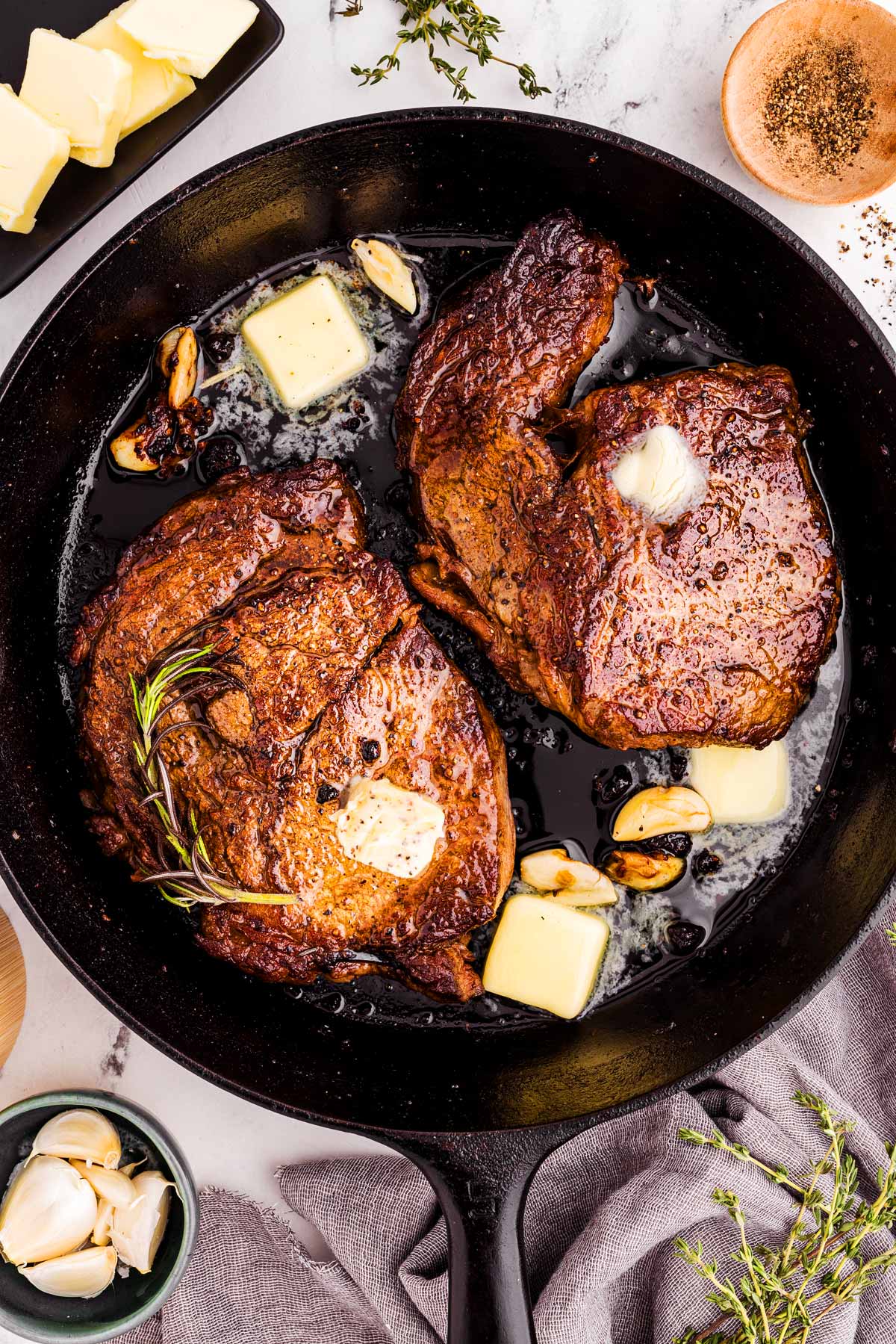
How to serve it (and what to do with leftovers)
This steak is at its peak right after it’s had its 10-minute beauty rest—juicy, buttery, and ready to impress.
Slice it against the grain (always!) for max tenderness, and serve it up with something simple but delicious: crispy roasted potatoes, buttery asparagus, or a sharp little green salad with lemon vinaigrette or homemade ranch if you’re feeling indulgent.
I like serving the steaks topped with a pat of additional butter (or homemade garlic butter!). If you’re going to have steak, you might as well go all out 😉
✨ Want date-night vibes without the babysitter? Add a glass of red wine and some garlicky bread, and you’ve officially out-steaked your local steakhouse.
Leftovers? Let the steak cool to room temperature, then store it in an airtight container in the fridge for up to 3 days. Slice ‘em thin and throw them in a sandwich, wrap, or salad the next day. You’ll be the kind of person who “just happens” to have steak in the fridge—and that’s a flex.
So… how’d your steak turn out?
Did you nail that sear? Baste like a boss? I want to hear all about it! Drop a comment, leave a star rating, or just Pin the recipe so you’ve got it ready the next time you’re craving steakhouse vibes without the price tag!
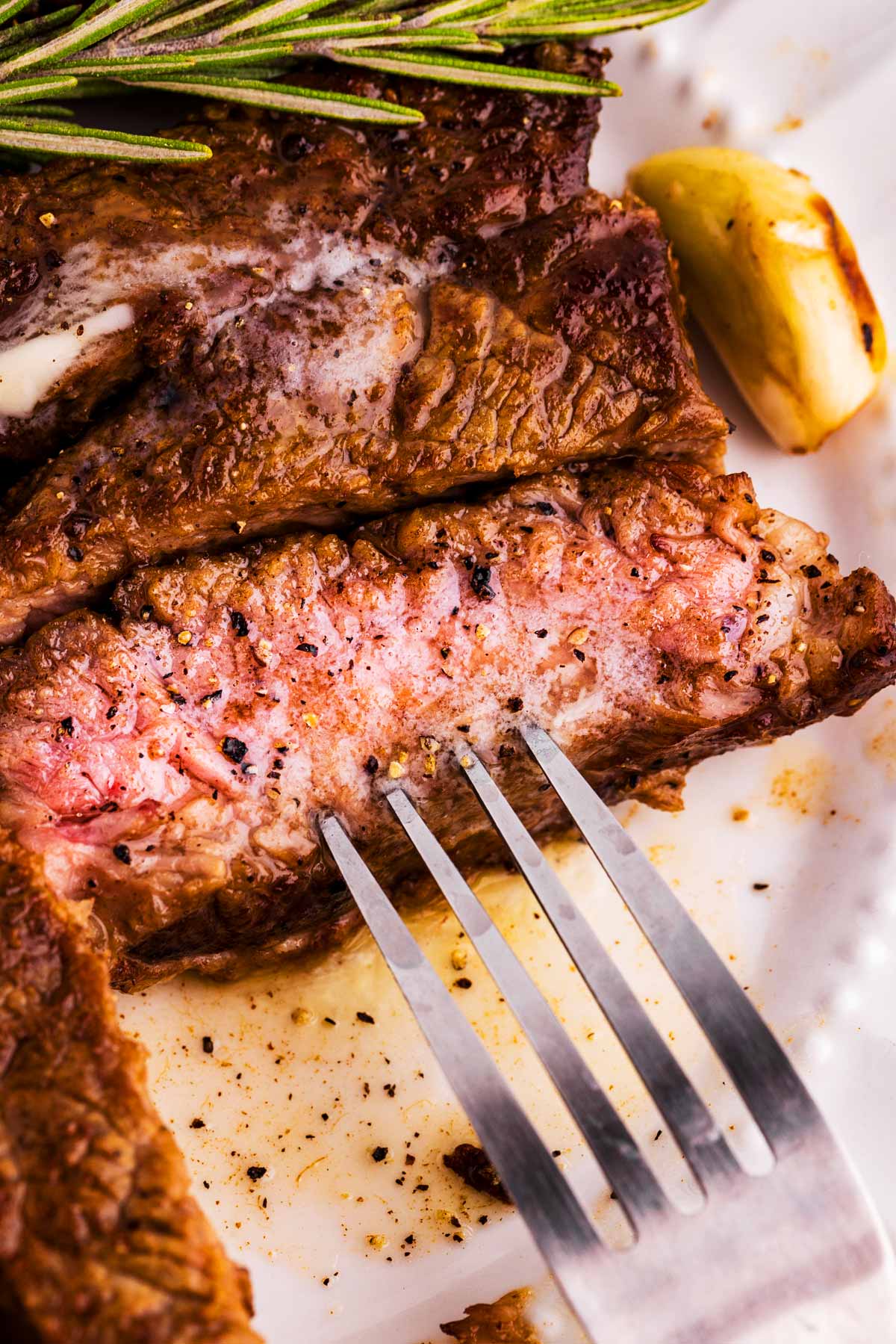



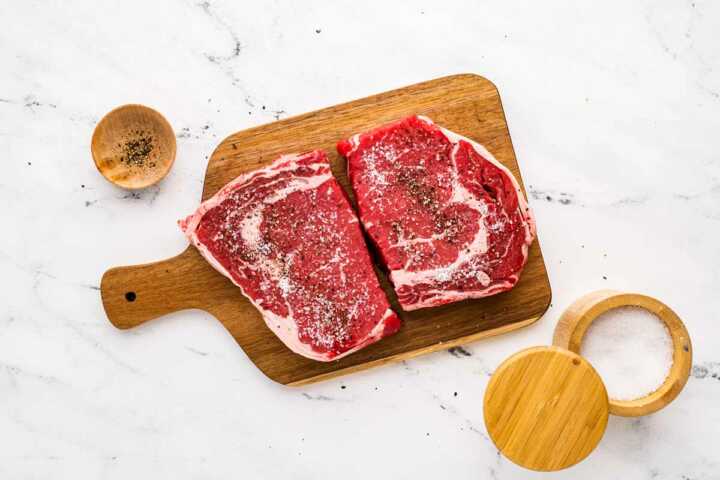
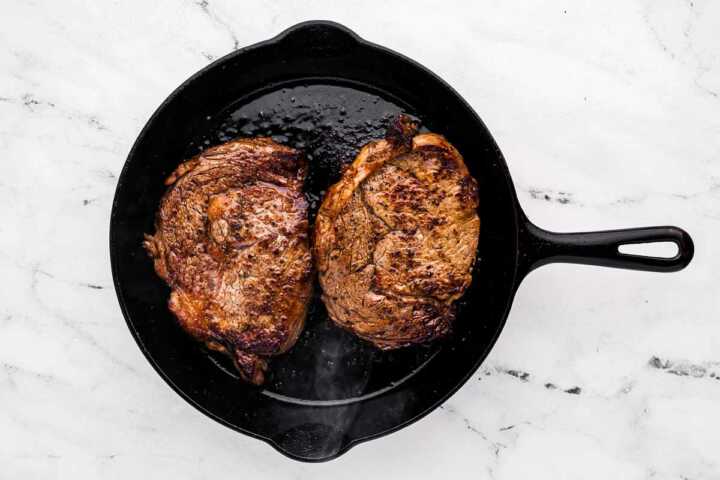

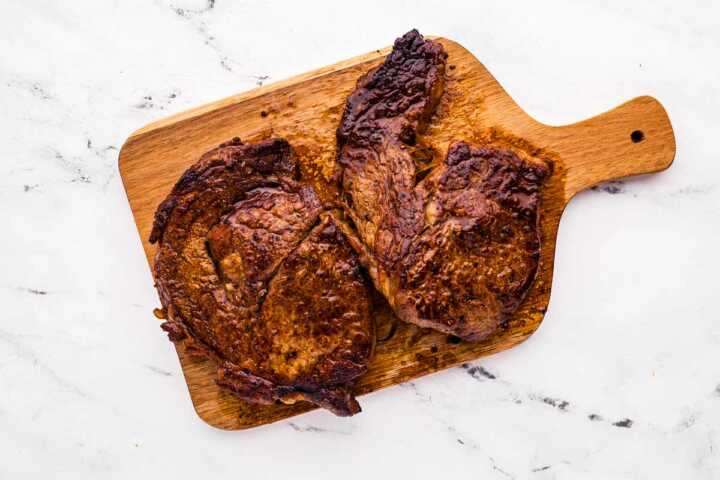
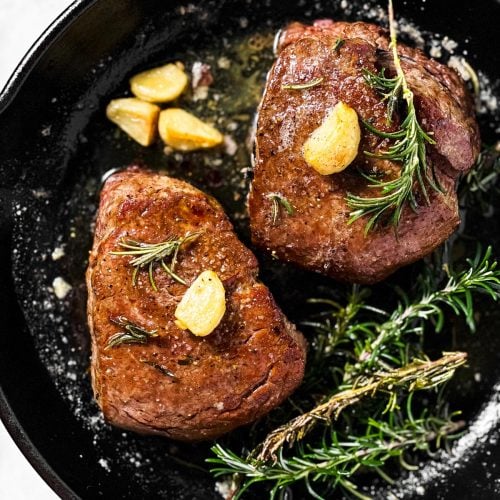
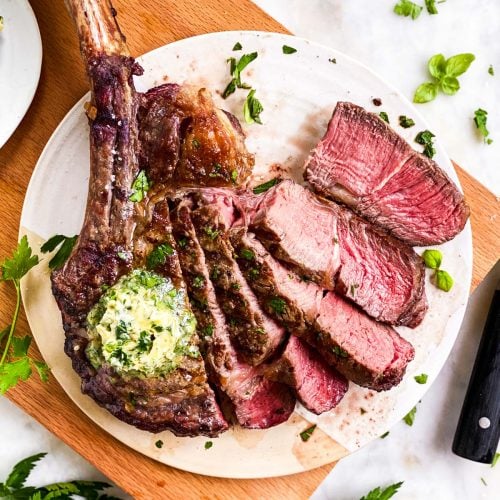
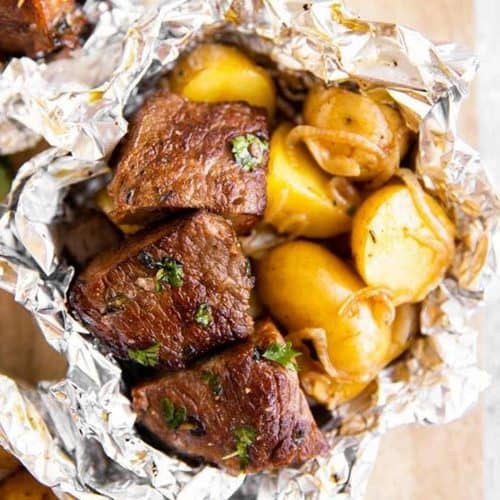
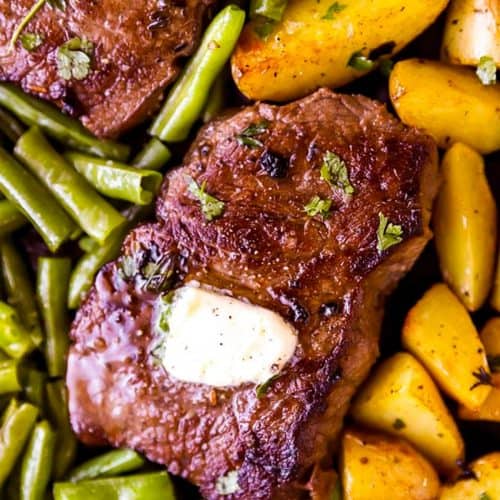



Michael says
I followed the recipe and took my time to do it correctly and it came out perfect. So tasty So good
Nora says
So glad to hear it, Michael!